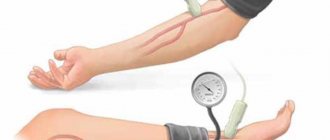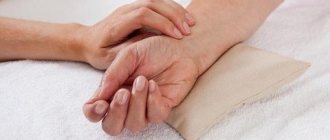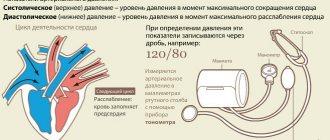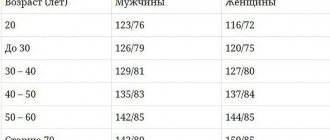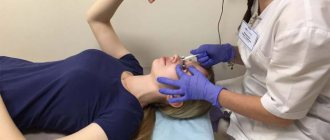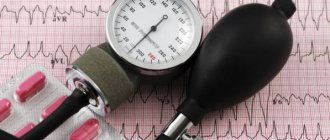What pressure is considered normal?
Blood pressure levels vary depending on age, health status and other factors affecting the human body.
Human blood pressure: age indicators
In a healthy adult, approximately the following indicators are considered normal::
- up to 40 years – 125-130/80 for men, 120-125/80 for women;
- up to 50 years – 130-135/85 for men, 130-135/85 for women;
- up to 60 years – 139/85 in men, 139/85 in women;
- 70 years and older – 140/89 in men, 140/89 in women.
For children, the normal systolic pressure can be calculated in this way:
- children under one year old – 76 + 2 x N (where N is the child’s age in months);
- children over one year old – 90 + 2 x N (N in this case is the number of full years).
Diastolic pressure is calculated as follows:
- children under one year old - 2/3-1/2 from the upper limit of normal systolic pressure;
- children over one year old – 60 + N.
In turn, the upper limit of the norm is determined as follows::
- systolic – 105 + N;
- diastolic – 75 + N.
Mechanical tonometer for measuring blood pressure included
Bottom line:
- systolic – 75 + 2 x N;
- diastolic – 45 + N.
Although there are accepted blood pressure standards, it is still recommended to build on your individual normal values, the so-called “working” pressure. To know your blood pressure, you need to measure it at rest.
How to measure blood pressure correctly
Measurements are usually taken on the left hand, but this is the case if the person is right-handed. Therefore, in order to obtain the most accurate results, this factor must always be taken into account.
The most difficult way to measure blood pressure is with a manual tonometer. Working with such a device requires some skills. But this device is more practical and reliable, since its operation does not depend on battery charge.
A mechanical tonometer consists of a bulb, which is attached to a cuff using a rubber tube. The same element is attached to the monometer. Also included is a phonendoscope, with which you can listen to the sound manifestation of the indicators.
Pressure measurement process:
- The cuff must be placed on the forearm. The area should be selected so that it is two to three centimeters higher from the elbow.
- The cuff should fit tightly around the arm and be secured with Velcro.
- The hearing part of the stethoscope is inserted into the ears, and the membrane amplifier is applied to the inside of the limb, in the area where the pulsating artery is located.
- Next, you should check that the meter needle is at zero. If this is not the case, it means that there is air in the cuff (you need to deflate it all the way) or the determiner is broken (in this case it will not be possible to measure correctly).
- After this, you need to tighten the valve on the bulb, thereby preventing air from escaping during injection.
- Then you need to inflate the cuff by repeatedly squeezing and unclenching the bulb. This must be done until the arrow on the monometer becomes higher than the expected number. It is recommended to choose this indicator based on previous measurements.
- After this, the air pumping must be stopped and the valve on the bulb must be slowly unscrewed.
- The arrow on the screen will gradually move down. She should be monitored closely.
- The first knock that appears in the auditory part of the phonendoscope is an indicator of upper pressure.
- A clear tone will be heard for a while. Then it will begin to subside. The moment when the sound disappears completely and is indicated by the number of the lower, that is, diastolic blood pressure.
- The air from the cuff must be completely deflated and you can remove it from your hand.
It is much more convenient to take measurements using automatic and semi-automatic partings. They don't require much practice.
Anyone can handle such devices. You can choose an electrical device for the forearm and hand.
An automatic tonometer is a device consisting of a cuff and a display. It also needs to be put on the hand, but that’s where all human participation ends. He himself pumps the air to the required levels and releases it himself. The final results are displayed on the screen. The disadvantage of this device is that it can only measure if it has batteries. And if the batteries do not have sufficient charge, errors in the indicators are possible. If you decide to choose such a device, you will need to regularly monitor the condition of the charging elements.
The operating principle of a semi-automatic tonometer is partly similar to an automatic device. It also records the numerical results of systolic and diastolic blood pressure without assistance, but cannot pump air on its own. To do this, there is a bulb through which you need to pump it into the cuff with your own hands. Further, the electrical mechanism itself records the numerical indicators at which the artery straightens (based on changes in air pressure in the cuff).
It is preferable to measure blood pressure at home. This is due to the fact that in a familiar environment a person is more relaxed and does not experience the stress that can be observed in a hospital.
Author of the article: Kristina Borisova
Measuring instruments
To diagnose blood pressure at home, two types of tonometers are used:
- Analogue tonometers or aneroid sphygmomanometers. These are devices of mechanical-acoustic type. They are quite simple to operate and maintain. They have a long service life, but require adjustment and calibration during long-term use. Mechanical instruments record values and numbers more accurately than automatic instruments.
- Electronic blood pressure monitors. They can be either automatic or semi-automatic. These devices are designed specifically for diagnosing blood pressure at home. They are convenient and do not require special skills from the patient when measuring. The cost of these devices is slightly higher than that of mechanical analogues. The only negative is a small error after frequent use.
Schedule and technique for measuring blood pressure
How to measure pressure with a tonometer in such a way that you can determine a person’s daily blood pressure profile? After all, hypertensive patients and people with heart disease should very carefully monitor changes in this indicator. A more accurate idea of the state of the heart muscle will be obtained by performing the procedure in question multiple times throughout the day. The first time the pressure is measured early in the morning, 1 hour after waking up. The second indicator is recorded 1 hour after lunch. The best hours for evening measurements are 19:00-20:00.
You need to prepare a little before measuring blood pressure. Here are some conditions that must be met in order for automatic blood pressure monitors to show reliable results:
- The last meal should take place at least 2 hours before the procedure;
- Smoking, drinking alcohol and caffeinated drinks are prohibited;
- Before the procedure, vasoconstrictor drops and sprays should not be used;
- before measuring blood pressure, a person must exclude any types of physical activity, and if there is any, they must rest for half an hour;
- during the procedure itself, a person should not strain his muscles, talk, laugh or worry - all this can significantly distort the results;
- If before the procedure a person was exposed to cold or extreme heat for a long time, at least an hour should pass before measuring blood pressure.
Reliable results can only be counted on if all of the above conditions are met.
Moreover, we should not forget about the stress received by the body during the procedure. It is the latter that can become several tens of mmHg. Art. As mentioned above, the technology for using advanced new devices is somewhat different from that described.
If all conditions are met before the measurement procedure and the cuff is correctly positioned on the arm, the device will do almost all the work on its own. After the start of the procedure, after some time the results will be displayed on an electronic display. Tonometer models developed over the past year have a built-in memory function that allows them to remember and save results.
Preparing for measurement
Measuring blood pressure requires compliance with important rules and recommendations. Often patients refuse an electronic tonometer due to the discrepancy between the indicators and a mechanical device. However, this is a misconception among many. If the patient fulfills the requirements, the results of blood pressure measurements can be considered reliable.
So, to obtain accurate blood pressure readings when using a digital tonometer, you need to adhere to the following rules:
- Correct cuff size. In length - at least 80%, and in width - at least 40% of the arm circumference. An incorrect cuff size will distort blood pressure measurements.
- Cuff application. Its location should be even, distortions should not be allowed, and it should not be too loose or too tight in girth.
- Peace of mind while taking measurements. Maximum peace of the patient's body and emotional state ensures the accuracy of the results of the procedure.
- Refusal to carry out preliminary power loads and procedures. 1 hour before measuring blood pressure, you should avoid taking a shower or bath, as well as high physical activity and emotional outbursts. The accuracy of the results is also affected by the strong tea and coffee you drank before.
- Emptying the bladder. If the bladder feels full, it needs to be emptied, since pressure in the organ increases blood pressure.
- Limitation of movements. During measurements, the patient must remain motionless, not gesticulate with limbs, or engage in dialogue.
- Before measuring, sit quietly for 5-10 minutes.
- Abstain from alcohol and cigarettes for 1.5-2 hours.
The accuracy of the results depends on proper preparation for using the tonometer.
Advice. If the device operates normally, but at the same time shows different indicators, it is necessary to submit it for testing to the appropriate metrological center. When using the device at home, it is recommended to have it checked every 3 years.
Blood pressure is a variable indicator. It depends on a number of factors. Therefore, both in patients diagnosed with cardiovascular diseases and in completely healthy people, it can change several times during the day. The main factors influencing blood pressure indicators are:
- power loads;
- psycho-emotional state;
- weather;
- time of day (at night the pressure is much lower than during the day);
- nutrition.
If a patient measures his blood pressure several times a day and notices fluctuations, this is a natural, normal factor. The appropriate period for manipulation is the period of stabilization. Doctors advise taking measurements in the morning and before bed. Only these data can be considered objective, on which drug therapy can be based.
Correct posture
The patient's body position is the main criterion. It affects the accuracy of the results. Let us immediately note that measurements cannot be taken while standing or lying down. The most correct indicators will be if the patient takes a sitting position.
The recommendations will be as follows:
- Choose a comfortable position on a chair, leaning against its back.
- You can't cross your legs.
- Place the hand on which measurements will be taken on a flat surface, until it is completely relaxed. It is strictly forbidden to hold the upper limb suspended or lower it down.
- The hand should be at heart level.
- Ensure a stationary sitting position and do not engage in dialogue with anyone.
- Before the procedure, it is advised to take deep breaths and exhales several times, this allows you to restore blood flow and normalize your heart rate.
The pressure measurement procedure takes place in a sitting position.
Which hand should I measure on?
According to the recommendations of medical specialists, pressure should be measured on the “non-working” arm. That is, if a person is right-handed, then the pressure is measured on the left limb; if a person is left-handed, the opposite is true. At the same time, we note that reliable blood pressure data can be measured by measuring on both arms; the manipulations are repeated several times in a row. The interval between measurements is 5-10 minutes, so the average result is obtained, which the doctor relies on when prescribing treatment. The average is calculated by recording the results obtained over several days in a notebook, where the stability of the indicators of each hand will be visible. Subsequently, it is recommended to measure the pressure on the arm where the readings will be more stable.
Automatic blood pressure monitor
How to correctly measure blood pressure with an automatic tonometer? As practice shows, in comparison with a mechanical device, an electronic tonometer is significantly inferior in diagnostic accuracy. Electronics are more sensitive, so any slight violation in determining blood pressure can affect the final result.
Using an electronic blood pressure monitor is quite simple. It is enough to put the cuff on your arm and turn on one button on the device. Next, automatic inflation of air into the cuff of the device will begin. In a semi-automatic device, air is pumped using a bulb. Taking readings, as well as deflating the cuff, in both cases is carried out by the device itself.
Electronic devices
Methods for measuring pressure with an electronic device:
- Before putting on the cuffs, the shoulder of the arm is released. It is necessary to remove the sleeve of the outerwear so that it does not pinch the upper part of the shoulder. The best option is to monitor blood pressure in both arms. For self-measurement, the cuff is placed on the non-dominant arm. However, the correct readings will be on the arm on which the blood pressure level is higher than on the other.
- The hand is placed on a flat surface; this can be done on a table or armrest of a chair. In this case, the extensor part of the forearm is on the surface, and the limb is in a relaxed state.
- Check the condition of the electronic device. It should not have any damage, kinks or bends on the surface of the hose.
- Separate the edges of the cuff. Put it on the shoulder using a circular wrapping method, a little higher (two fingers) from the elbow. In this case, the air supply hose should pass exactly in the middle between the conditional line of the middle of the bend of the elbow and the middle finger of the hand.
- If the device cuff is marked with a fitting line, position it so that it is in the middle position inside the upper arm.
- Start the device by pressing a button.
- Wait while the device pumps and deflates air. Be in a relaxed state and do not touch the device.
- Numbers will appear on the device display. The top indicator is responsible for systolic pressure, the bottom for diastolic pressure. Many devices also record heart rate. This value will appear lower than others. In this case, diastolic blood pressure will be located above the pulse, in the middle column.
- Turn off the device using the button and wait until it turns off completely.
- Remove the cuff from your shoulder. Diagnostics completed!
An automatic tonometer is very convenient and should be present at home for every hypertensive patient.
How to measure your blood pressure with a manual tonometer video
Hypertension is the scourge of a civilized society; every third person suffers from it after the age of 40. Therefore, in order to independently regulate blood pressure, it would be useful for everyone to learn how to measure it for themselves and their loved ones.
Mechanical tonometer
Advantages of a mechanical tonometer
Therefore, both the general practitioner called to your home and the ambulance paramedic will most likely use a mechanical device.
The advantages of such a device:
- has a simple design;
- allows you to measure pressure with maximum accuracy;
- rarely fails;
- does not require battery replacement;
- suitable for hands of any size, including children’s;
- lasts longer than electronic ones;
- affordable.
Hand-held device
A manual tonometer for measuring pressure is an air-filled cuff with Velcro, connected by hoses to a rubber pump - a bulb and a meter (manometer). The cuff is wrapped around the patient's shoulder and fastened. The bulb is equipped with a screw-on valve. By compressing it several times, air is pumped into the cuff.
In addition, some devices come with a phonendoscope for listening to blood impulses in the arteries. These blood pressure monitors are certainly more convenient.
Types of mechanical devices
Manual mechanical tonometers are produced by various manufacturers. The variety of models allows a person to choose a device in accordance with his wishes and financial capabilities. The table below shows examples of the most popular mechanical devices.
| Manufacturer | Microlife, Switzerland | B.Well, UK | Little Doctor, Singapore | Rudolf Riester, Germany |
| The presence of a phonendoscope in the kit | No | Eat | No | Eat |
| Measurement error, mm Hg. Art. | ±2 | ±3 | ±3 | ±3 |
| Cuff dimensions, cm | 14.5 x 53 | 25–40 | 14 x 53 | 54.5 x 14.5 |
| Device weight, g | 360 | 385 | 237 | 390 |
Preparing to measure blood pressure
The manipulation should be performed in a relaxed state, calmed down and not nervous. To reduce the likelihood of receiving erroneous results, you need to properly prepare for measuring pressure:
- At least 2 hours before the procedure, give up coffee, alcohol, smoking, and medications that act on blood vessels.
- Do not undergo significant physical activity before taking measurements.
- Immediately before the procedure, empty your bladder.
- You can measure your blood pressure 30 minutes after eating.
Which blood pressure monitor should you choose?
Types of tonometers and their comparative characteristics are presented in the table.
| Characteristic | Mechanical | Semi-automatic | Auto |
| Composition of the apparatus | Cuff, bulb, pressure gauge, phonendoscope | Cuff, bulb, electronic device | Cuff, electronic device |
| Air injection | On your own, with the help of a pear | On your own, with the help of a pear | Device |
| Decreased air pressure in the cuff | On your own, with the help of a pear | On your own, with the help of a pear | Device |
| How to determine blood pressure level | Using a phonendoscope | Appliance yourself | Appliance yourself |
| Where is the result displayed? | Pressure gauge scale | Electronic scoreboard | Electronic scoreboard |
| Additional options | No | Counting the pulse, determining its rhythm | Counting the pulse, determining its rhythm |
| Difficulty level | Difficult | Average | Easily |
| Possibility of independent use | Difficult, requires some skill | Easily | Easily |
| Measurement reliability | High with adequate skill in using the device | Depends on power supply or battery quality | Depends on power supply or battery quality |
| Price | Low | Average | High |
In order to decide which tonometer to choose for a particular person, you need to take into account several factors, for example:
- ability to use the device or the possibility of training;
- age;
- living together with someone who will help in measuring;
- concomitant diseases accompanied by hand weakness or trembling;
- level of hearing and vision;
- other individual factors.
As can be seen from the table, measuring blood pressure with an electronic tonometer is easier than with a mechanical one, because it does not require special skills in listening to tones with a phonendoscope. This factor plays an important role when buying a device for an elderly person.
Some patients may find it difficult to adjust the valve on the bulb when inflating and deflating air from the cuff, in which case it is better to use an automatic tonometer.
Also, when choosing a device, you need to remember who will use it: if a person lives alone, then it is better to abandon the mechanical one, and measure pressure with a semi-automatic tonometer or an automatic one.
Measurement errors
For the accuracy of the results, it is necessary to exclude all external as well as internal factors that change the final result. Therefore, the measurement is carried out in complete peace, comfortable conditions for humans.
- Incorrect preparation for the procedure. The last consumption of strong caffeine-containing, alcoholic, and energy drinks should occur no later than an hour before the procedure. Serious physical activity should be completed 2 hours before, and meals should be completed half an hour before measurement.
- Pressure is measured in a sitting position, with the torso resting on the hard back of a chair. The arm needed for research should be bent and lie on top of the table, resting on the elbow. The general condition of the subject is relaxed, without gesturing or talking.
- Rolling up of the sleeve, incorrect placement of the cuff. It should be placed on the forearm 2-3 cm above the bend of the elbow. This will bring the compression zone closer to the level of the heart. Conductive air ducts should be placed along the inner surface of the arm from the elbow to the hand.
- Bleed air speed. If the valve is opened too far, the first beat (tone) will be difficult to hear. Therefore, it is worth doing this smoothly at a rate that is 10-20 points higher than usual, without increasing the air discharge rate until the upper and then lower values are accurately established.
- Frequency of repeated measurements. To obtain an accurate result, it is recommended to perform three consecutive blood pressure measurements, with an interval of 3-5 minutes. During this time, the blood flow manages to restore the vessels narrowed by air injection. Therefore, the time interval between approaches cannot be reduced.
. Next, it is carried out on the hand where the indicators are higher.
Tonometer cuff
If the cuff does not fit, the large one will dangle on the forearm, and the small one will begin to tighten too much. In both cases, the result of measuring blood pressure will be biased, so you should take the choice of a blood pressure cuff seriously.
Since mechanical devices are more often used by medical staff, the devices are equipped with a wide variety of cuffs: for newborns, children, a hip version, etc. However, for home use, you should choose a standard cuff with a pneumatic chamber length of 25-40 cm.
For electronic tonometers, you can choose a cuff of the following sizes:
- for children (15-22 cm);
- medium (22-32 cm);
- universal (22-42 cm);
- large for overweight people (32-42 cm).
It is most convenient to buy a tonometer with a universal cuff, but doctors still advise choosing the size according to the build of the person who will use the device more often than other family members.
Now let’s move on to the question that worries many: on which arm is blood pressure measured?
Features of measuring pressure with a mechanical tonometer
Each person could see how to do it correctly when undergoing a medical examination.
The procedure is quite simple and takes no more than 5 minutes. The obtained indicators are influenced by the patient’s age, weather, the presence of pathologies and body position, therefore small deviations from the norm within 10-15 units are allowed. It is quite simple to understand how to measure your own blood pressure using a mechanical tonometer if you familiarize yourself with the following algorithm of actions:
- Sit comfortably on a chair, straightening your legs, leaning completely against its back and placing your hand on the table, bending it at the elbow. The limb should remain at chest level to obtain the most accurate readings. It is first necessary to free her from clothing so as not to further compress the artery.
- Place the cuff just above the elbow (around the forearm). It is important that there is no air in it. Otherwise, the obtained values may differ slightly from the true indicators. The cuff should be tightened, but not too tight. If it hangs freely on your arm, then low pressure will be recorded. Otherwise, the indicators will be overestimated and the person will experience discomfort during the procedure due to pinching of the limb. You can tell that the cuff is on correctly by inserting 2 fingers under it. If the manipulation is difficult, but realistic, then everything is correct.
- Find the brachial artery slightly above the elbow and apply a sound membrane to it. It is not advisable to hold it with your thumb. It will reflect its own pulse, which will interfere with listening to tones. Experts advise fixing the stethoscope head with your index or middle finger. It is equally important to place it slightly below the edge of the cuff so that additional noise is not created.
- After checking that the cuff is securely fastened and leaning the sound membrane to the desired place, take the pear with the other hand. Close the valve firmly (clockwise) so that air does not escape during the pumping process.
- Start pressing hard on the pear. The cuff will inflate, thereby compressing the artery. Continue the process until the readings on the pressure gauge screen are 160-180 mmHg. Art. Then open the valve on the bulb slightly so that air begins to escape from the cuff. Its speed should not exceed 1-2 units to successfully record values.
- While releasing air, try to hear the first tone. It is the upper (systolic) threshold, which shows the force of blood pressure on the vessels at the moment of cardiac contraction.
- Gradually the noise will increase. Having reached its maximum, it will begin to subside. The last tone heard is the lower (diastolic) threshold. It shows the force of blood pressure during complete relaxation of the heart muscle.
- Indicators equal to 120/80 (+-10-15 units) are acceptable. If the pressure is higher or lower than normal, then after 3 minutes you will have to measure again. If a negative result is confirmed, it is recommended to consult a doctor.
Having figured out how to measure blood pressure without leaving home, you can protect yourself from the development of hypertension or hypotension by periodically using a tonometer. To obtain more accurate data, it is advisable to remember the following tips:
- When measuring the blood pressure of a large person, problems often arise with the size of the cuff. The forearm may be too large. In this case, you will have to purchase a device specifically for the individual characteristics of the structure or go to the hospital for measurements. For kids, the situation is exactly the opposite. Their hand is too small, so they will have to buy a child cuff.
- When performing the procedure on yourself or another person, you must remain silent and turn off third-party devices that make sounds in order to hear the tone.
- Before repeating the measurement, at least 3 minutes must pass. The hand was pinched, so it takes time for it to return to normal. Otherwise, the indicators will be overestimated.
- For convenience, the pressure gauge can be hung on clothing when taking measurements for another person or placed on the table in front of your eyes.
On which arm is blood pressure measured?
As already mentioned, the first time the pressure should be measured on both hands in turn. To determine which arm you need to take your blood pressure afterwards, follow a simple procedure. To do this, it is necessary to determine blood pressure readings on each arm several times with an interval of 3 minutes after each measurement. This will allow you to get accurate results.
All values should be entered into a table with two columns that reflect the parameters for the left and right hands. Then the obtained values must be compared. If the readings are higher on one of the hands, the pressure should be measured on it. If the parameters are the same, right-handed people need to take measurements on their left hand, and left-handed people need to take measurements on their right hand.
It is important that the difference in values does not exceed 10 mm Hg. Art. Exceeding this indicator indicates the development of serious pathologies.
Please note: Doctors note that the parameters of the left hand indicate the functioning of the upper limbs, heart and lungs. The values of the right hand make it possible to identify anomalies of other structures - the stomach, liver, intestines, pelvic organs, pancreas.
Many people wonder what the dangers of the difference in performance are. Scientists say that this seriously increases the likelihood of vascular diseases of the brain and limbs. As a result, the possibility of developing a stroke and other dangerous consequences increases.
Significant differences in tonometer readings on the left and right sides may result in various symptoms. The most common symptoms that occur are:
- weakness;
- decreased reaction speed;
- the appearance of dizziness.
If there are stable differences in the indicators, you should consult a doctor and undergo a detailed medical examination.
Blood pressure measurement
The pressure will return to normal! Just remember once a day.
The procedure for measuring pressure using a mechanical tonometer boils down to the following steps.
- It is necessary to take a comfortable sitting position, and the hand on which you plan to measure blood pressure is placed on a stable surface somewhere at the level of the heart and relaxed.
- You need to put the cuff on the upper limb just above the elbow (approximately 2 cm) and fasten it with a Velcro fastener.
- Next, insert the phonendoscope olives into the ears.
- Then the membrane amplifier of the phonendoscope is applied to the inner area of the elbow joint where the pulsating vein is located.
- Then you need to close the air release valve located in close proximity to the bulb and inflate the cuff.
- It is necessary to stop when the pressure gauge shows a value exceeding the normal operating indicator of upper pressure characteristic of a particular person.
- Next, you should stop inflating the cuff and slowly open the bulb valve, trying not to miss the initial impulse of blood, listening with a stethoscope - this is the value of systolic pressure (upper pressure).
- When the clear pulse rhythm subsides, the diastolic pressure indicator is noted - that is, the lower pressure.
- Upon completion of the measurements, all air should be released and the cuff should be removed from the upper limb.
Most people anticipate changes in blood pressure based on their own feelings
However, it is important to remember that a jump in blood pressure may go unnoticed if it is asymptomatic. This is why it is better to measure your blood pressure if you notice facial flushing or sudden throbbing in your temples, or when you feel dizzy
Often such signs are discovered after work overstrain or an unpleasant conversation, since stress and a jump in blood pressure are inseparable companions. However, pressure can increase due to atmospheric changes, increases in temperature, as well as due to changes in body posture or due to excessive physical activity.
For prevention, as well as in the above conditions, blood pressure should be measured in absolutely healthy individuals.
And if a person suffers from hypertension, diabetes, kidney disease and endocrine diseases, then the device should be used systematically (twice a day - morning and evening). In the morning, indicators are taken from both upper extremities, due to which sclerotic phenomena are detected in the vessels of the arms. Measurements are taken in the evening after taking all medications, in a relaxed state.
As a rule, the arterial norm for a healthy person is 120/80. However, deviations also occur, which are often known to the patient. Often they affect the upper limit of values. But the worst option is considered if the upper and lower blood pressure values are closer. Blood pressure is systematically monitored in pregnant women. It must be remembered that low blood pressure is no less dangerous in its manifestations. That is why symptoms such as weakness, drowsiness and staggering in an upright position should be a signal to check your blood pressure readings.
Even children are susceptible to problems with low and high blood pressure, so if your child complains of dizziness or headache, it would also be useful to measure the pressure.
Such symptoms may be a manifestation of a hidden disease. However, you need to remember that the cuff for a baby should be narrower, shorter and appropriate for his age.
Many of our readers actively use a well-known method based on natural ingredients, discovered by Elena Malysheva, to TREAT HYPERTENSION. We recommend that you check it out. Read more.
Common mistakes
Very often, when measuring blood pressure with a mechanical tonometer, people make a number of mistakes. As a result, the data obtained is incorrect. Therefore, you need to know how to correctly measure blood pressure at home. A person can make a number of common mistakes.
Incorrectly fitted cuff
There are devices with a wrist cuff. But such devices have a number of limitations - they are not recommended for use by obese people and patients over 45 years of age. If a tonometer is purchased for the whole family, it should have a shoulder sleeve.
Wrong cuff size
This is a fairly common mistake that occurs when using a tonometer at home. The size must be selected according to the person's shoulder circumference. If the cuff is too long, this will lead to an underestimation of blood pressure; if it is too short, this will cause it to be overestimated. To determine blood pressure correctly with a mechanical tonometer, the length of the inflating part of the cuff should be about 80% of the patient’s upper arm circumference. And the width of the cuff of the measuring device should be approximately 12-14 cm. Typically, the device includes a sleeve designed for the average adult. Children and obese people may need to purchase an additional cuff.
Incorrect cuff size is one of the most common mistakes when measuring blood pressure with a mechanical tonometer.
Incorrect body position
Pressure must be measured at the level of the heart muscle. If the cuff is higher, the readings will decrease, and if higher than the level of the heart, they will increase. The person must be in an upright position. The doctor may recommend that the patient lie on his back, but the limb should rest against the table and be vertical.
Incorrect cuff application
It should not be placed on top of clothing. Sweater, jacket - all this must be removed, otherwise the data obtained may be incorrect. But a thin shirt should not affect the final result.
Too frequent measurements
You cannot measure pressure several times in a row on the same arm. After the first compression, the vessels can adapt to decompression. Therefore, in the future the device may show different results. Therefore, the interval between measurements should be at least 7-8 minutes.
Thus, you can use the tonometer at home. But this must be done correctly, otherwise the device will produce incorrect results. During the procedure, a number of rules and recommendations must be taken into account.
How to choose a tonometer for home use
The selection algorithm is simple. It is important to decide on a specific type of device, taking into account the frequency of use of the device, the age of the patient, the presence of cardiovascular diseases, etc. Which tonometer is more accurate - selection criteria:
- Frequency of operation and number of users. An automatic or semi-automatic device is suitable for frequent use, but if the number of users is more than one, it is recommended to choose a model with a memory function.
- Age category of the patient. Both shoulder and wrist pressure gauges are suitable for young and middle-aged people. An elderly patient should choose exclusively the shoulder. This is due to the fact that the vessels of the wrist joint wear out over time, the elasticity of their walls decreases, arthrosis (joint diseases) occurs, and bones begin to appear. All these factors can distort the accuracy of blood pressure measurements.
- Cuff size. The most popular are shoulder products - the shoulder in medical terminology means the area from the shoulder joint to the elbow. This type is available in several sizes, some of which are universal, others are suitable only for children or adults. Approximate breakdown in the table:
| Arm circumference midway between the shoulder and elbow joint (cm) | Size |
| 18-22 | Small (small) |
| 22-32 | Medium |
| 32-45 | Large |
- Presence of cardiovascular diseases. If the patient has problems with heartbeat (arrhythmia), then preference should be given to a device with an intelligent measurement function.
- Ability to measure pressure yourself. A mechanical sphygmomanometer is only suitable for doctors and nurses who know how to use it, because while measuring blood pressure you need to listen to the pulse with a stethoscope. For this reason, you should choose a semi-automatic/automatic machine for home use. It is stuffed with sensitive electronics, which will accurately determine your pulse.
- Company manufacturer. Popular manufacturers of pressure meters include AND and Omron (both Japan), Microlife (Switzerland), Beurer (Germany). Moreover, AND has a patented technology for oscillometric blood pressure measurement - it was the first to receive a patent for this technique, which is used in digital devices. Omron actively promotes its products among the Russian-speaking audience, which has a positive effect on the company's business.
